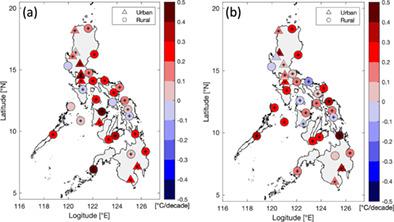当前位置:
X-MOL 学术
›
Int. J. Climatol.
›
论文详情
Our official English website, www.x-mol.net, welcomes your
feedback! (Note: you will need to create a separate account there.)
The effect of urbanization on temperature indices in the Philippines
International Journal of Climatology ( IF 3.5 ) Pub Date : 2021-06-27 , DOI: 10.1002/joc.7276 John A. Manalo 1, 2 , Jun Matsumoto 1, 3 , Hiroshi G. Takahashi 1 , Marcelino Q. Villafuerte 2 , Lyndon Mark P. Olaguera 4, 5 , Guoyu Ren 6, 7 , Thelma A. Cinco 2
International Journal of Climatology ( IF 3.5 ) Pub Date : 2021-06-27 , DOI: 10.1002/joc.7276 John A. Manalo 1, 2 , Jun Matsumoto 1, 3 , Hiroshi G. Takahashi 1 , Marcelino Q. Villafuerte 2 , Lyndon Mark P. Olaguera 4, 5 , Guoyu Ren 6, 7 , Thelma A. Cinco 2
Affiliation

|
This paper presents a comprehensive analysis of the effect of urbanization on the surface air temperature (SAT) from 1951 to 2018 in the Philippines. The daily minimum temperature (Tmin) and daily maximum temperature (Tmax) records from 34 meteorological stations were used to derive extreme temperature indices. These stations were then classified as urban or rural based on satellite night-lights. The results showed a significant difference in the SAT trends between urban and rural stations, indicative of the effect of urbanization in the country. Larger and more significant warming trends were observed in indices related to Tmin than those related to Tmax. In particular, the effects of urbanization were significant in the annual index series of Tmin, diurnal temperature range, minimum Tmin, percentage of days when Tmin was less than the 10th percentile (TN10p), percentage of days when Tmin was greater than 90th percentile (TN90p), and the number of coldest nights. The effects of urbanization were not as clear on the index series of maximum Tmax (TXx), minimum Tmax (TXn), percentage of days when Tmax was less than 10th percentile (TX10p), and the number of hottest days. The effects of urbanization on the annual series of extreme temperature indices were statistically significant at the 95% confidence level, with the exception of Tmax, TXn, TXx, TX10p, and the number of hottest days. Further analysis revealed that the effect of urbanization was the greatest during the DJF (December–January–February) season. These findings serve as a baseline study that focuses on the countrywide effect of urbanization on SAT trends in the Philippines.
中文翻译:

菲律宾城市化对气温指数的影响
本文全面分析了菲律宾 1951 年至 2018 年城市化对地表气温 (SAT) 的影响。使用34个气象站的日最低气温(T min)和日最高气温(T max)记录来推导极端气温指数。然后根据卫星夜灯将这些站点分类为城市或农村。结果显示,城市和农村站点之间的 SAT 趋势存在显着差异,表明该国城市化的影响。在与T min相关的指数中观察到比与T max相关的指数更大和更显着的变暖趋势. 尤其是T min、昼夜温差、最低T min、T min小于第10个百分位数(T N10p )天数百分比、T min大于第 90 个百分位 ( T N90p ),以及最冷的夜晚数。城市化对最大T max ( T Xx )、最小T max ( T Xn )、T max小于第 10 个百分位数 ( T X10p ),并且是最热天数。除了T max、T Xn、T Xx、T X10p和最热天数外,城市化对年度极端温度指数系列的影响在 95% 置信水平上具有统计学意义。进一步分析显示,在DJF(12-1-2月)季节,城市化的影响最大。这些发现可作为一项基线研究,重点关注全国城市化对菲律宾 SAT 趋势的影响。
更新日期:2021-06-27
中文翻译:

菲律宾城市化对气温指数的影响
本文全面分析了菲律宾 1951 年至 2018 年城市化对地表气温 (SAT) 的影响。使用34个气象站的日最低气温(T min)和日最高气温(T max)记录来推导极端气温指数。然后根据卫星夜灯将这些站点分类为城市或农村。结果显示,城市和农村站点之间的 SAT 趋势存在显着差异,表明该国城市化的影响。在与T min相关的指数中观察到比与T max相关的指数更大和更显着的变暖趋势. 尤其是T min、昼夜温差、最低T min、T min小于第10个百分位数(T N10p )天数百分比、T min大于第 90 个百分位 ( T N90p ),以及最冷的夜晚数。城市化对最大T max ( T Xx )、最小T max ( T Xn )、T max小于第 10 个百分位数 ( T X10p ),并且是最热天数。除了T max、T Xn、T Xx、T X10p和最热天数外,城市化对年度极端温度指数系列的影响在 95% 置信水平上具有统计学意义。进一步分析显示,在DJF(12-1-2月)季节,城市化的影响最大。这些发现可作为一项基线研究,重点关注全国城市化对菲律宾 SAT 趋势的影响。











































 京公网安备 11010802027423号
京公网安备 11010802027423号